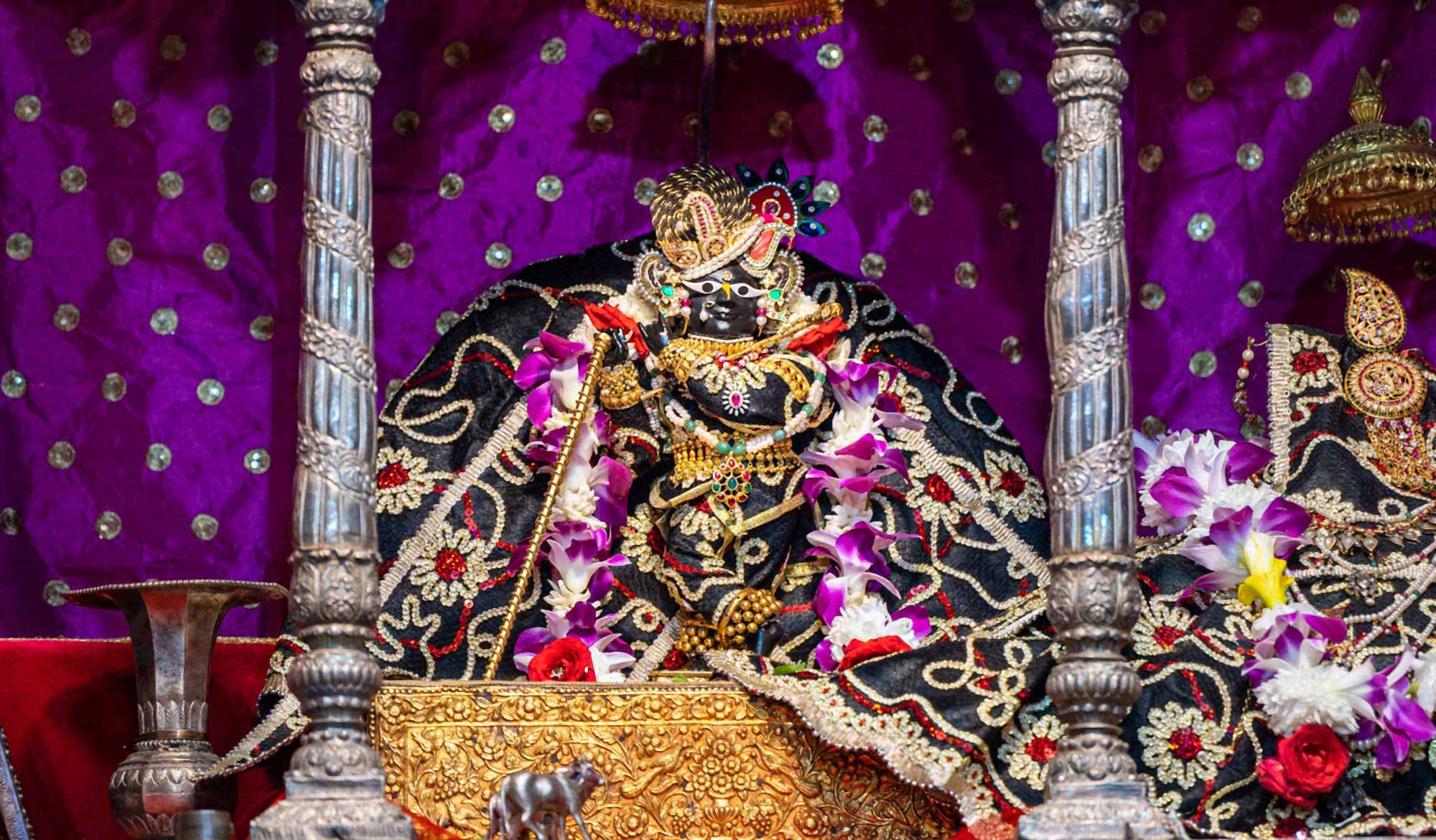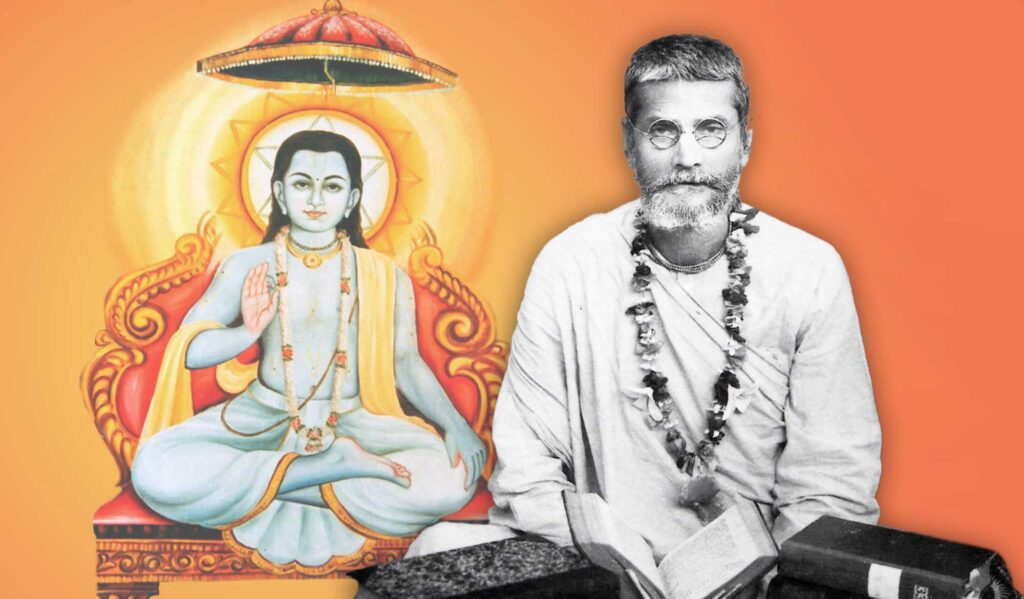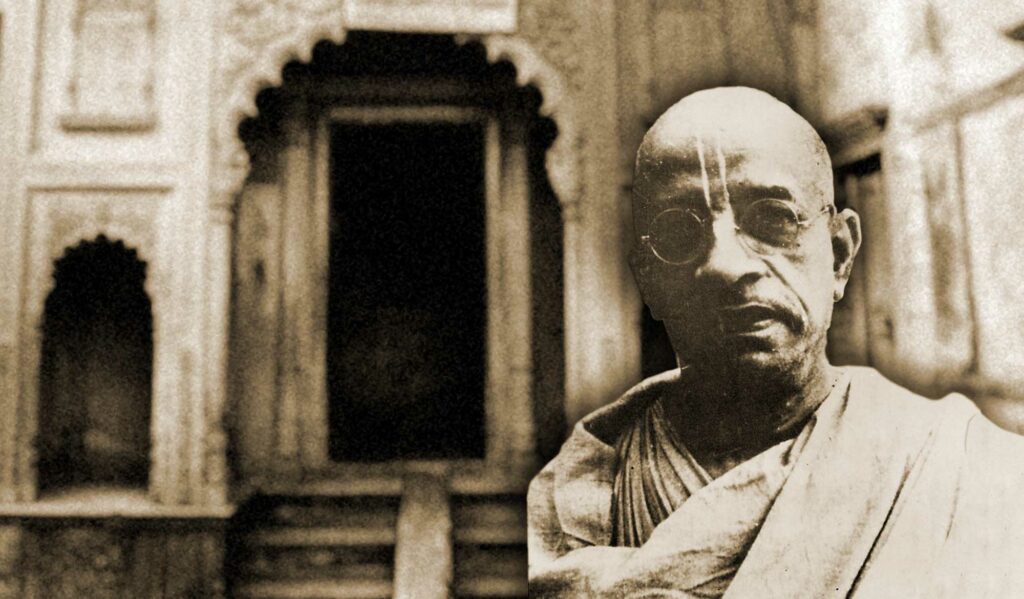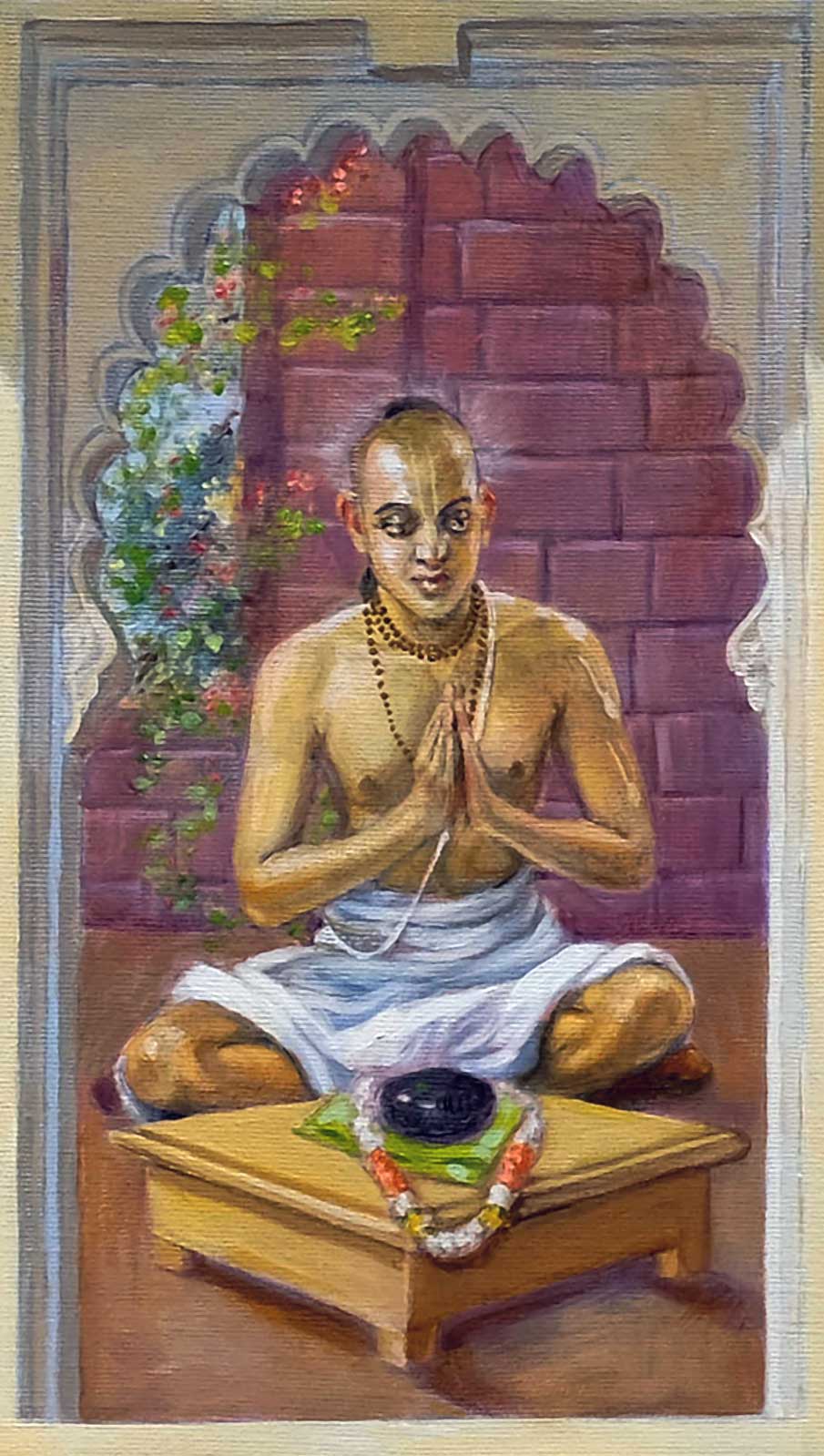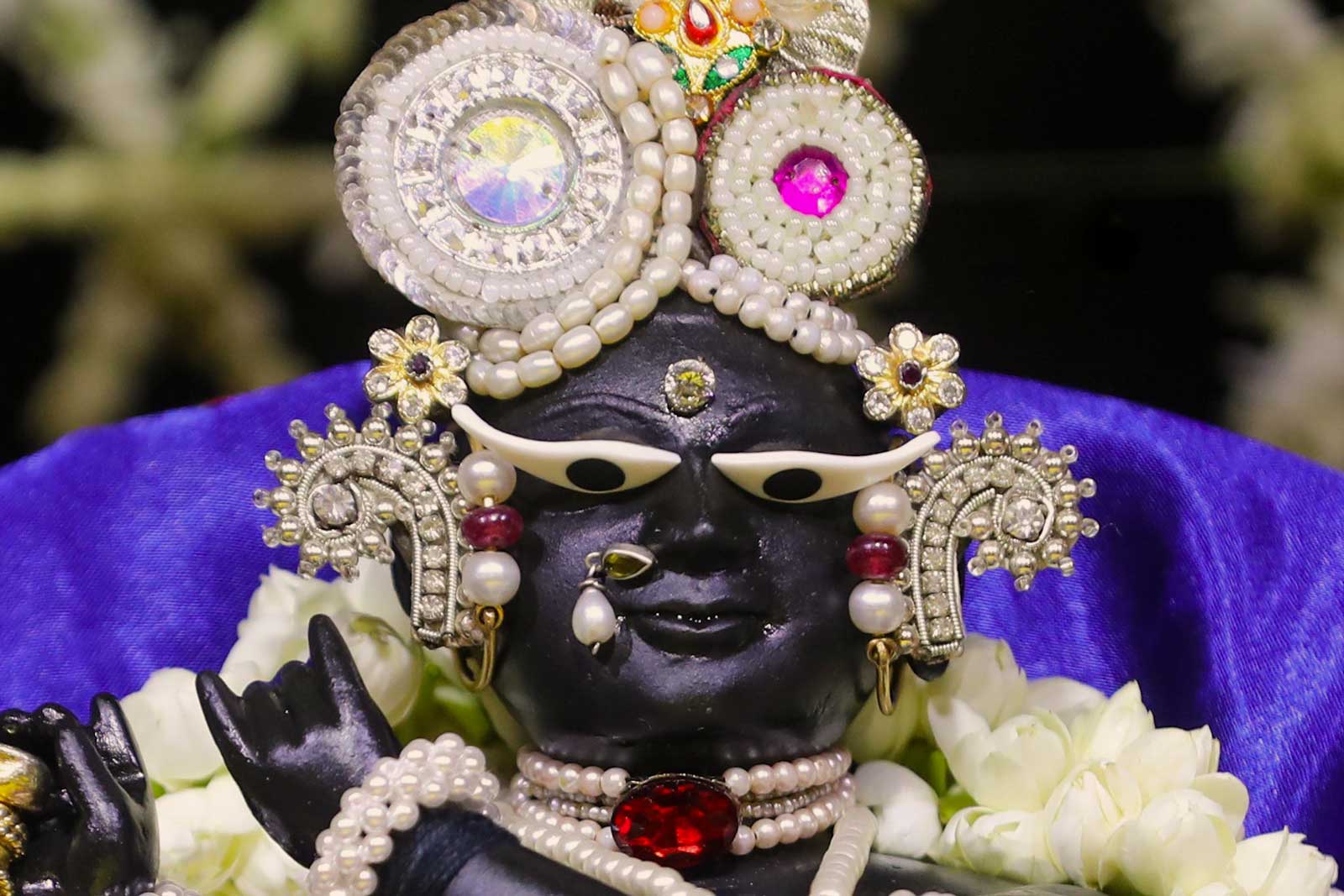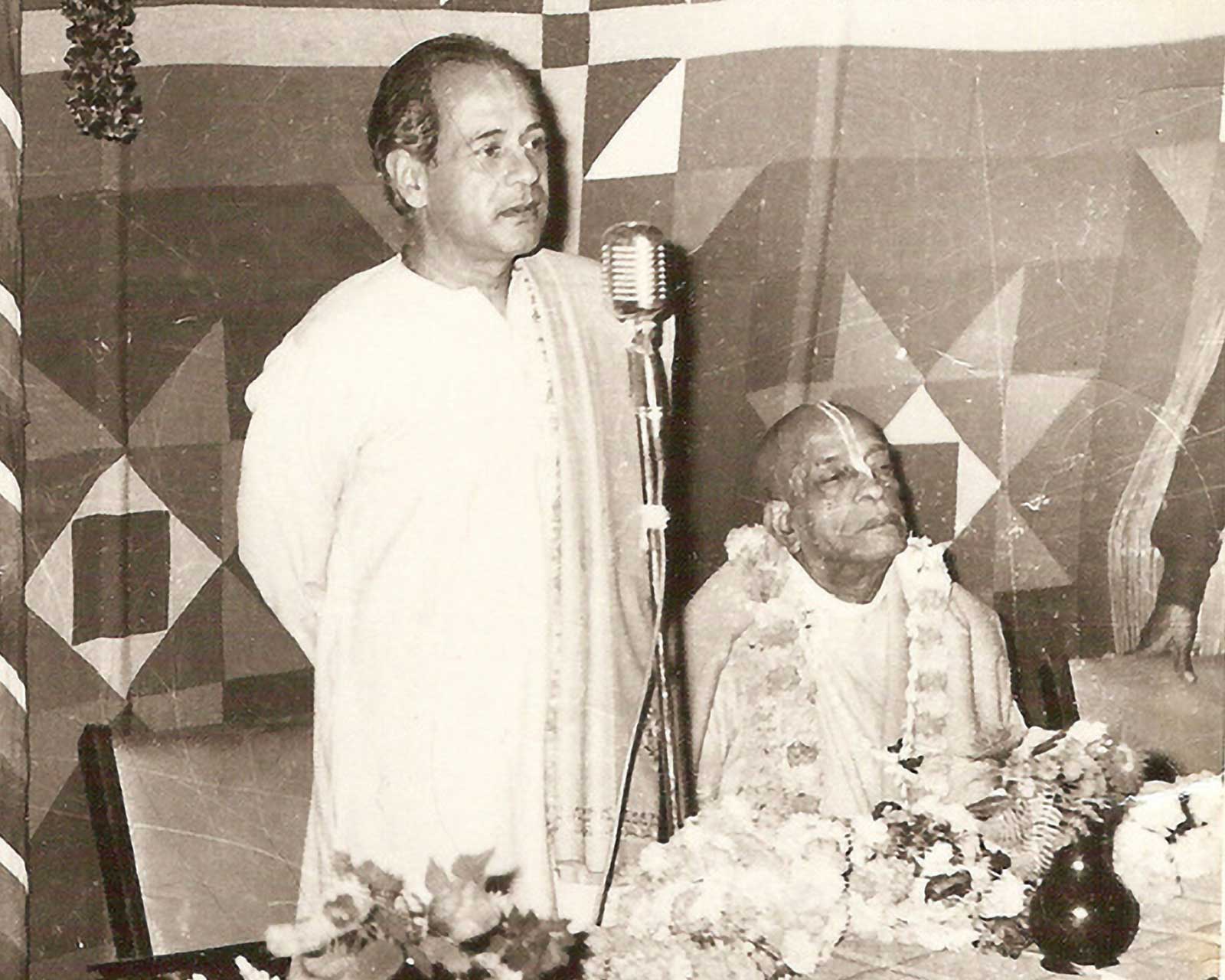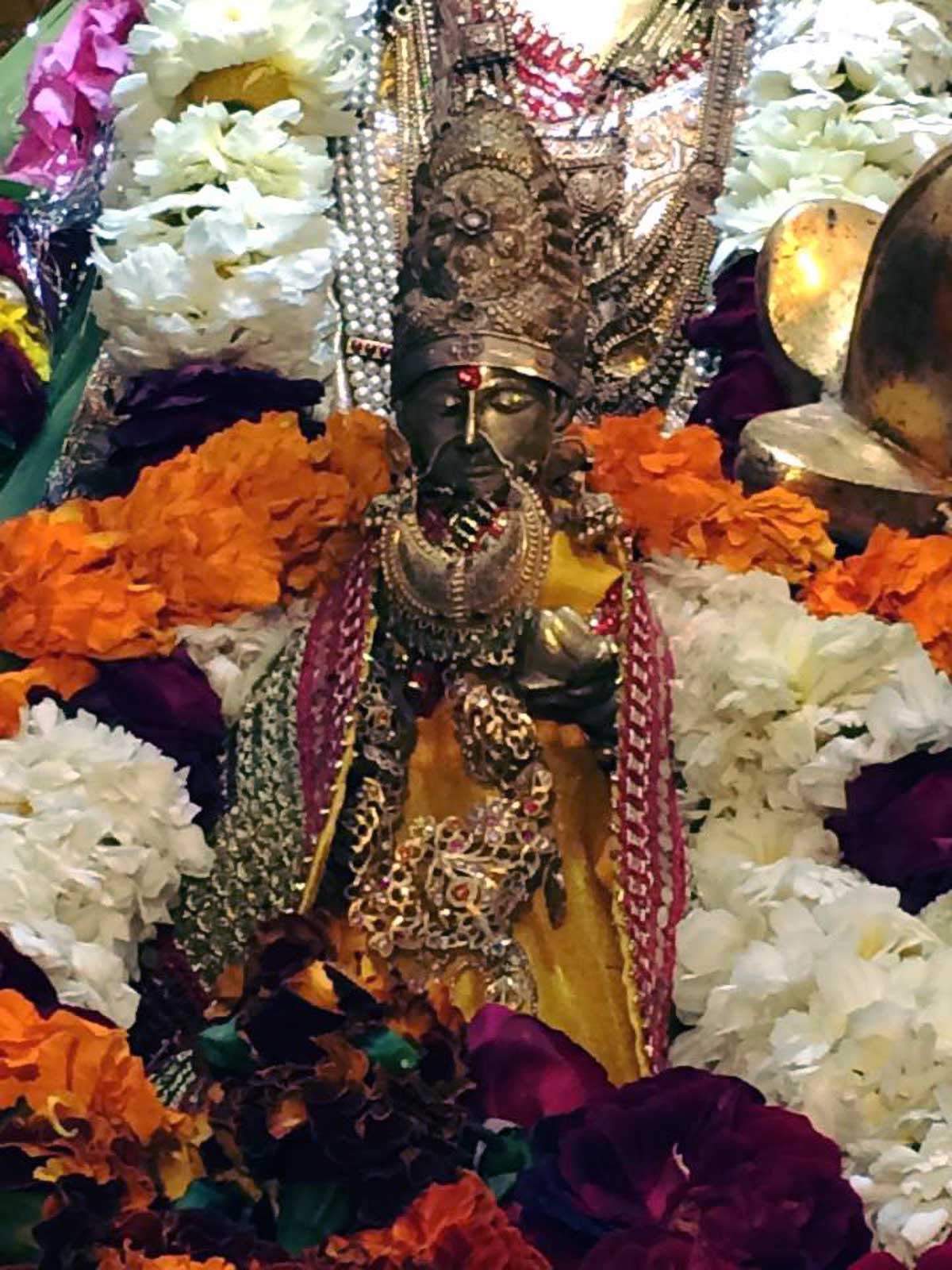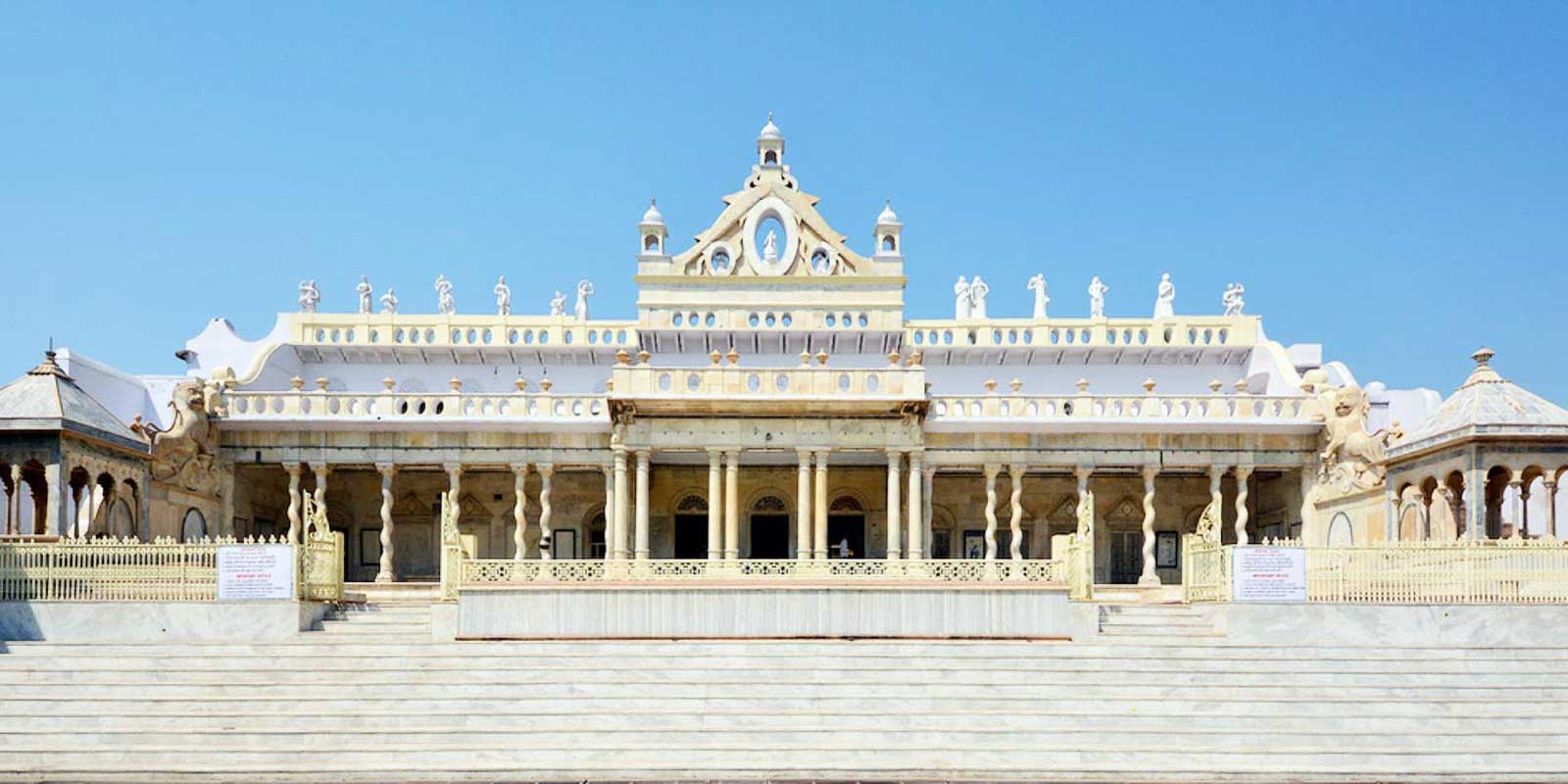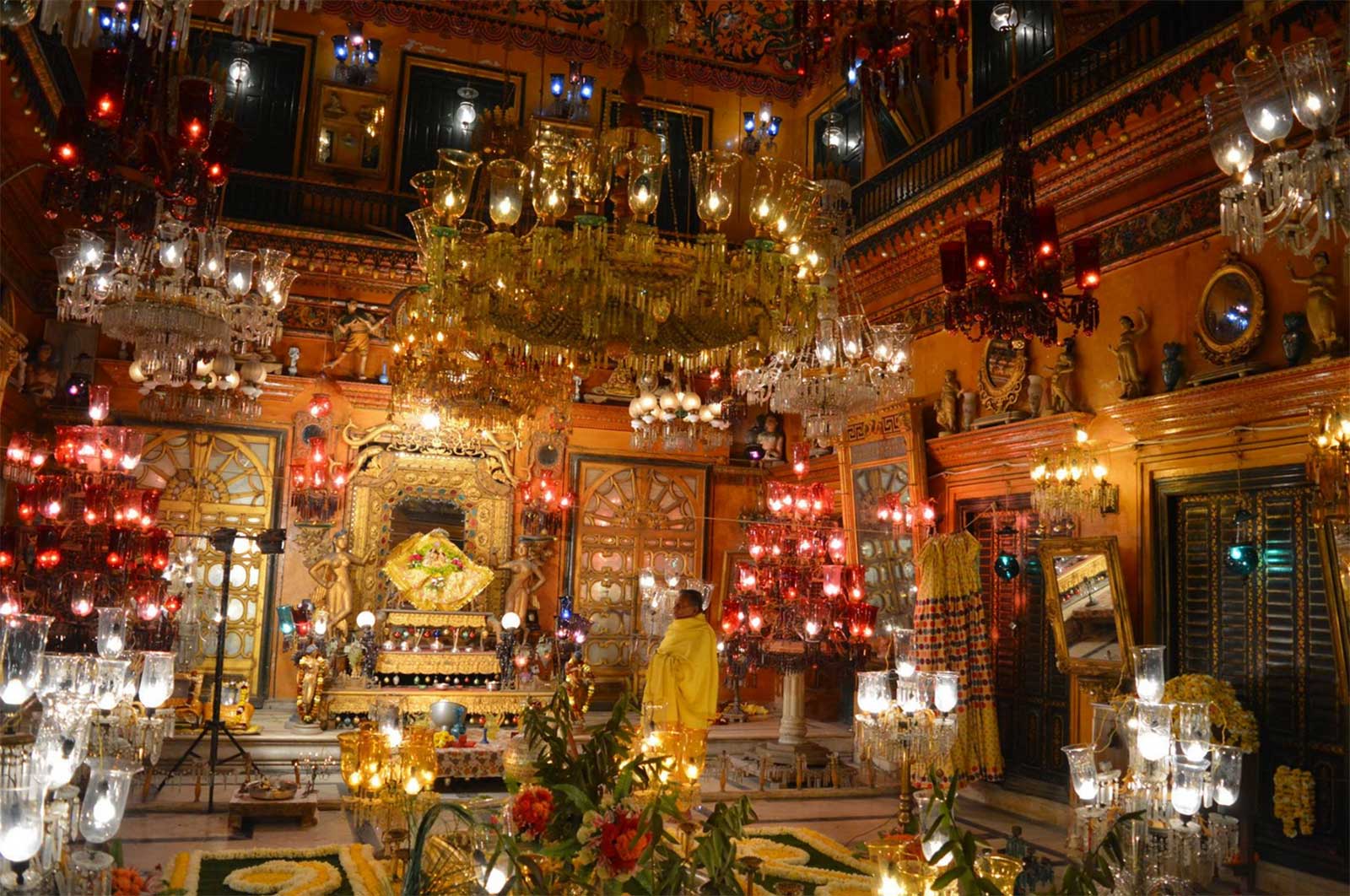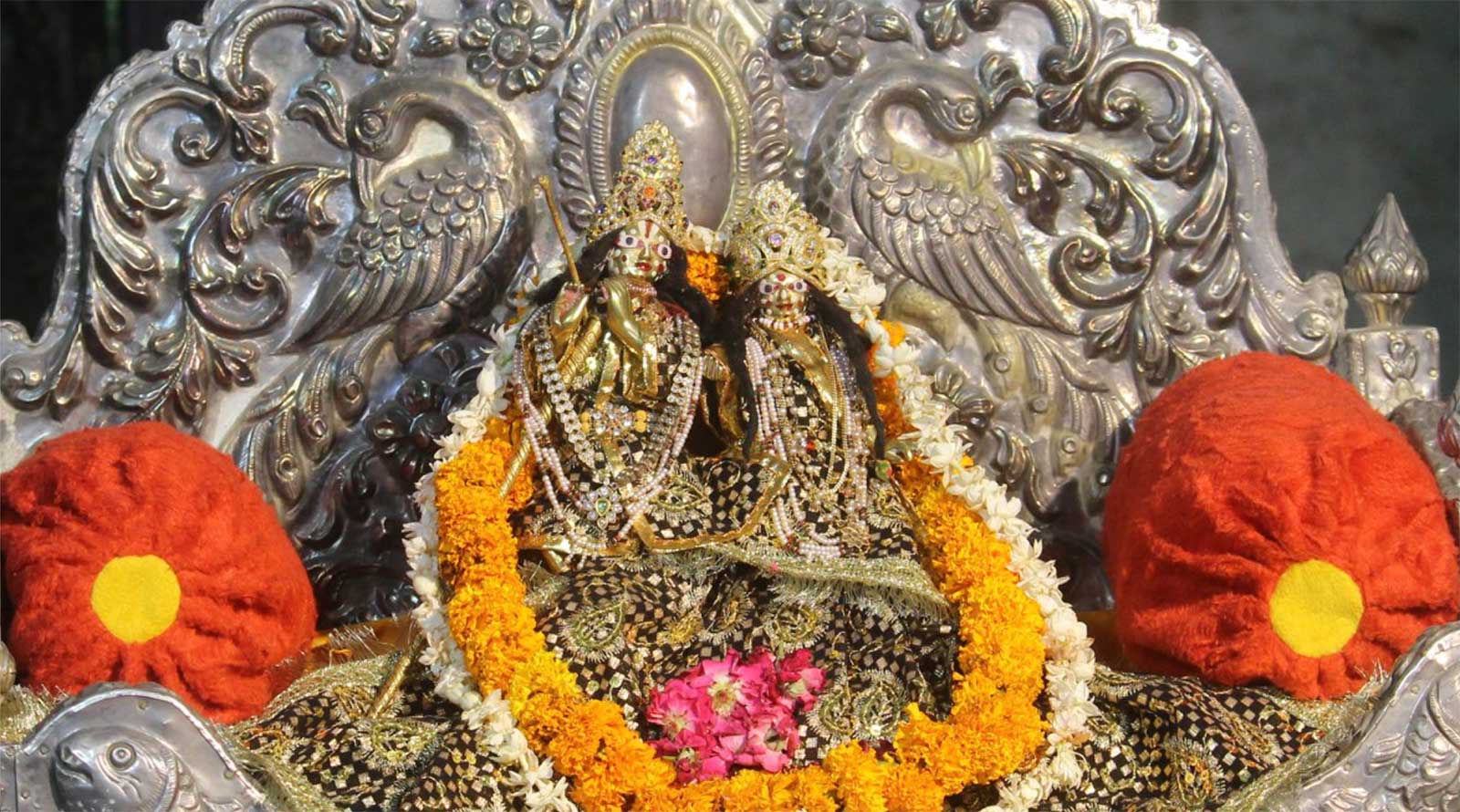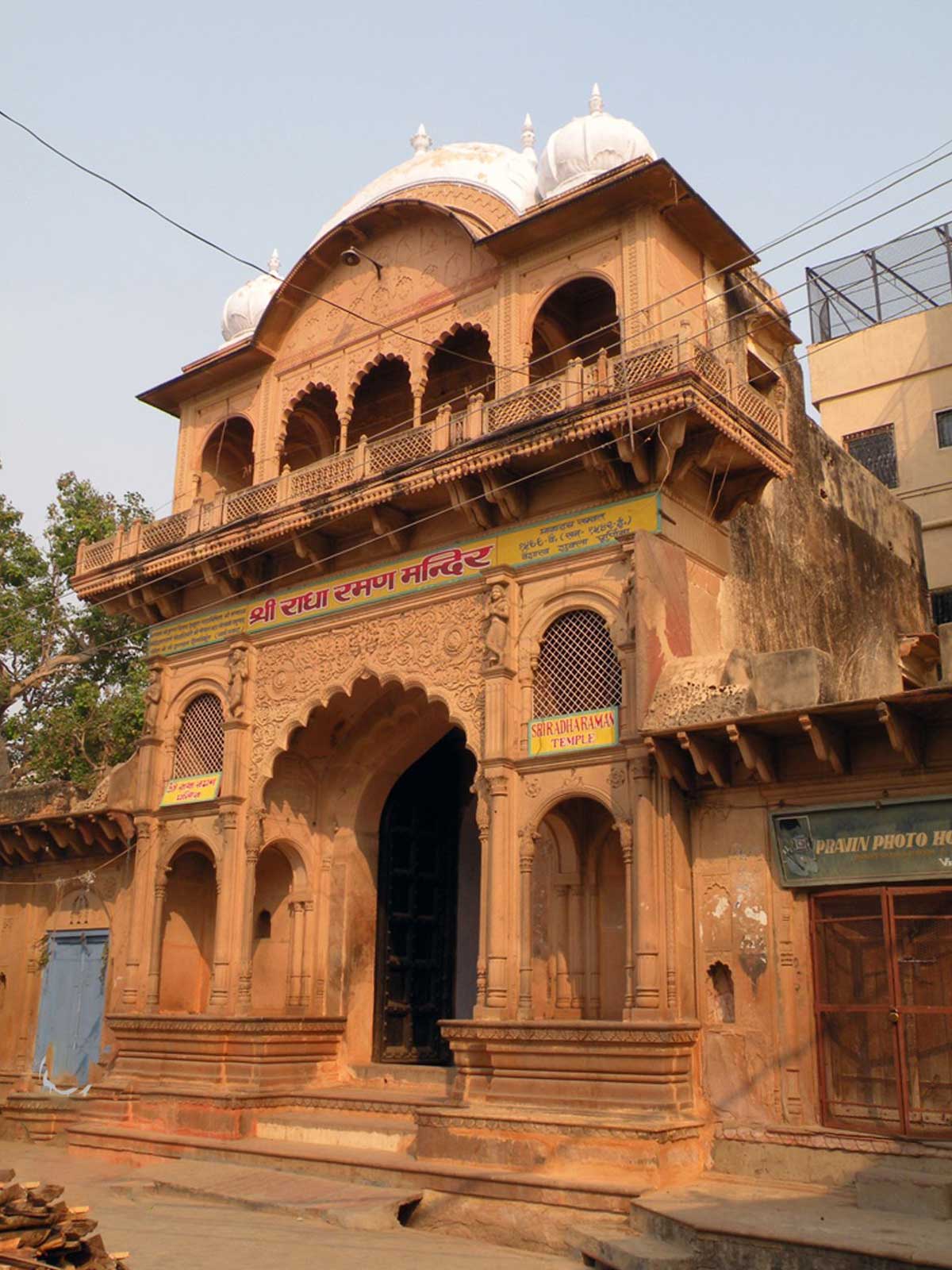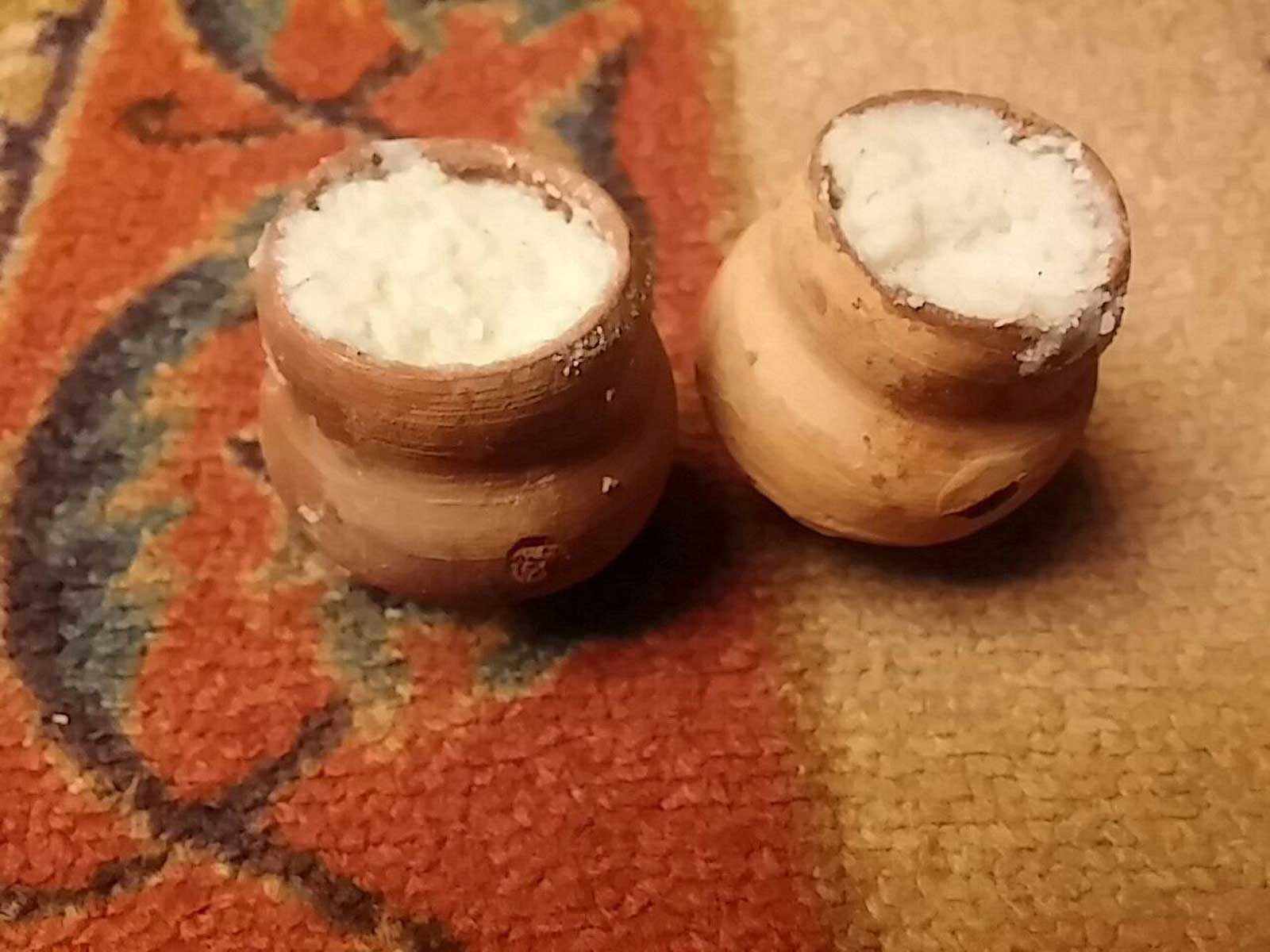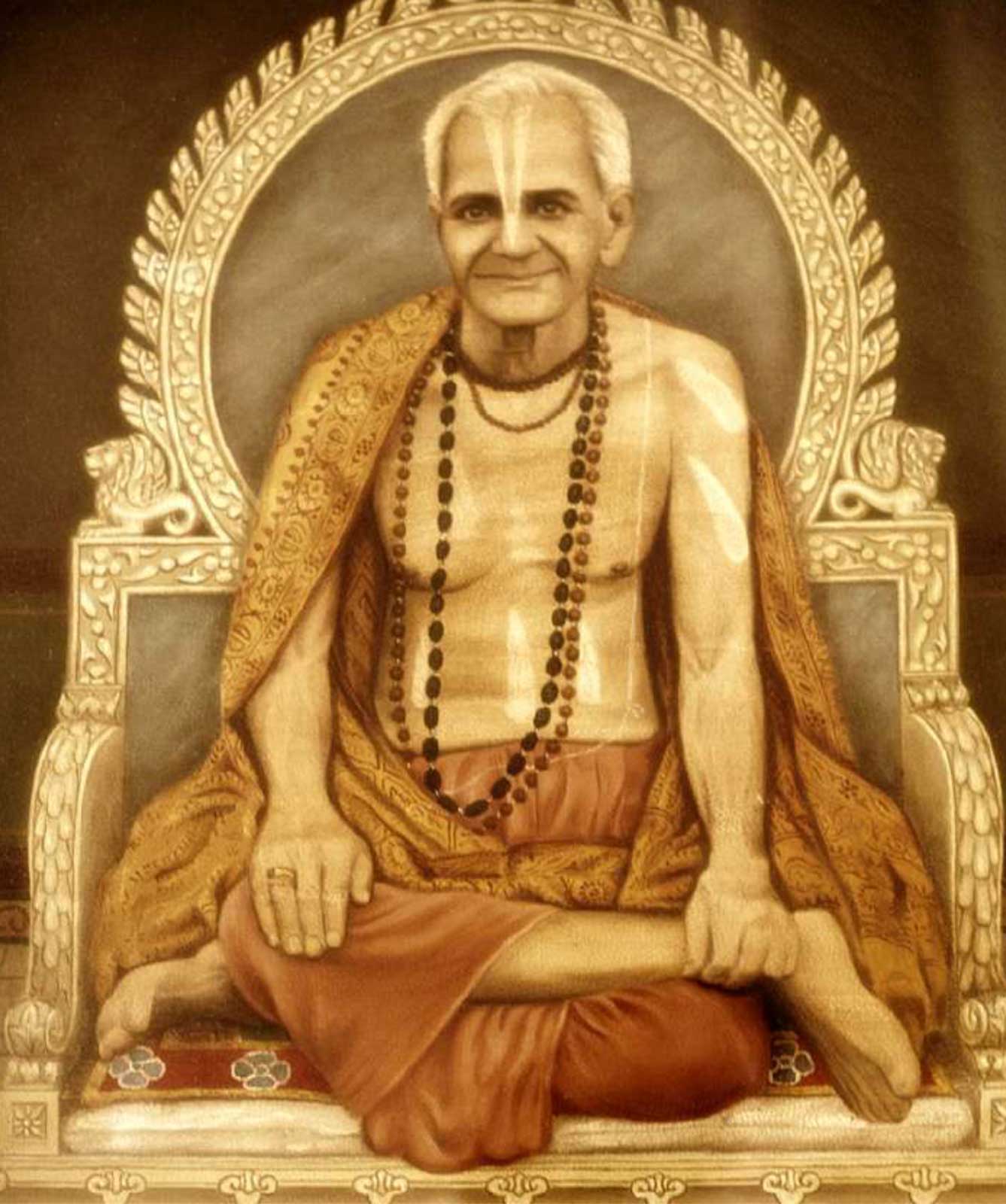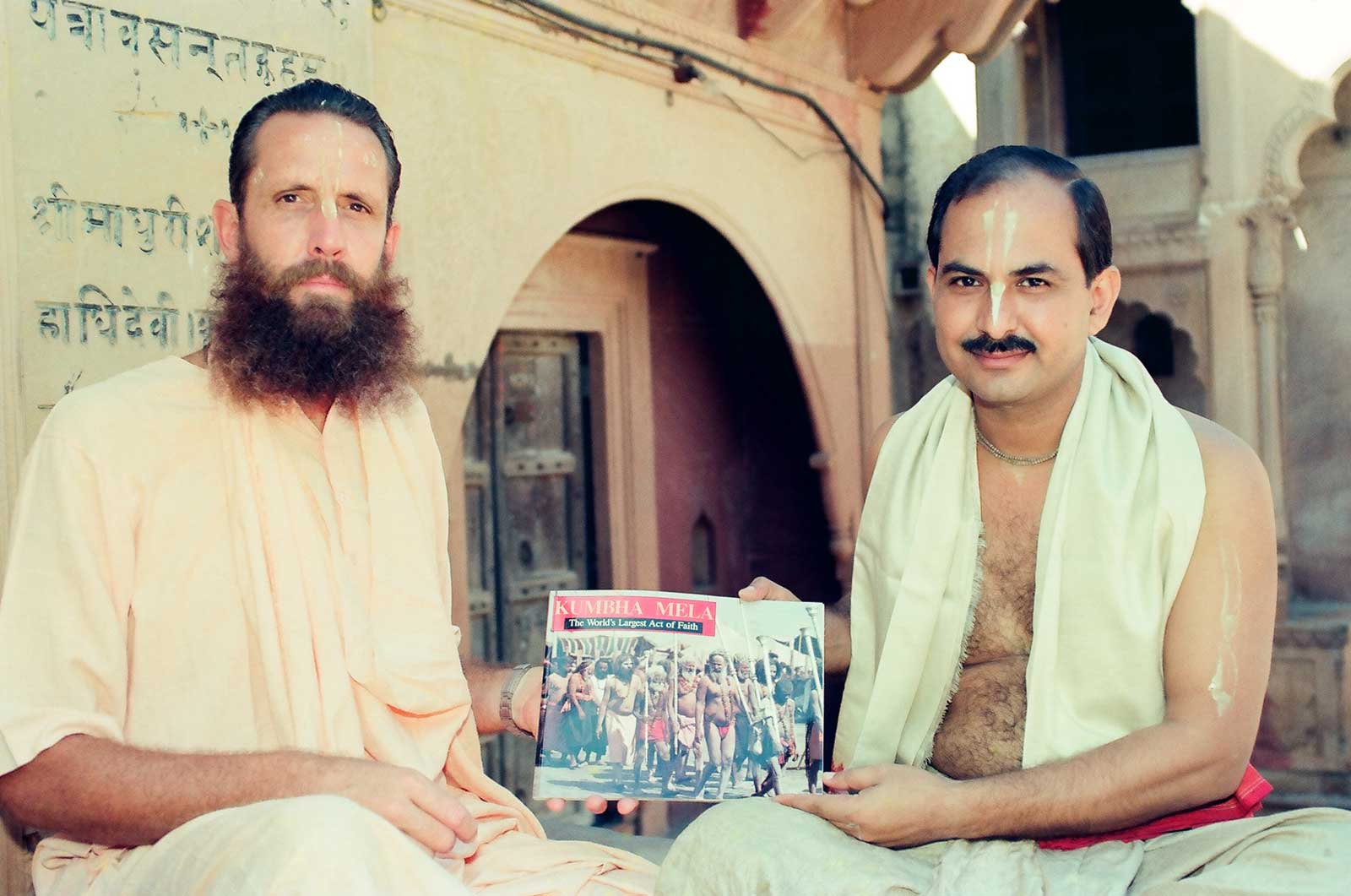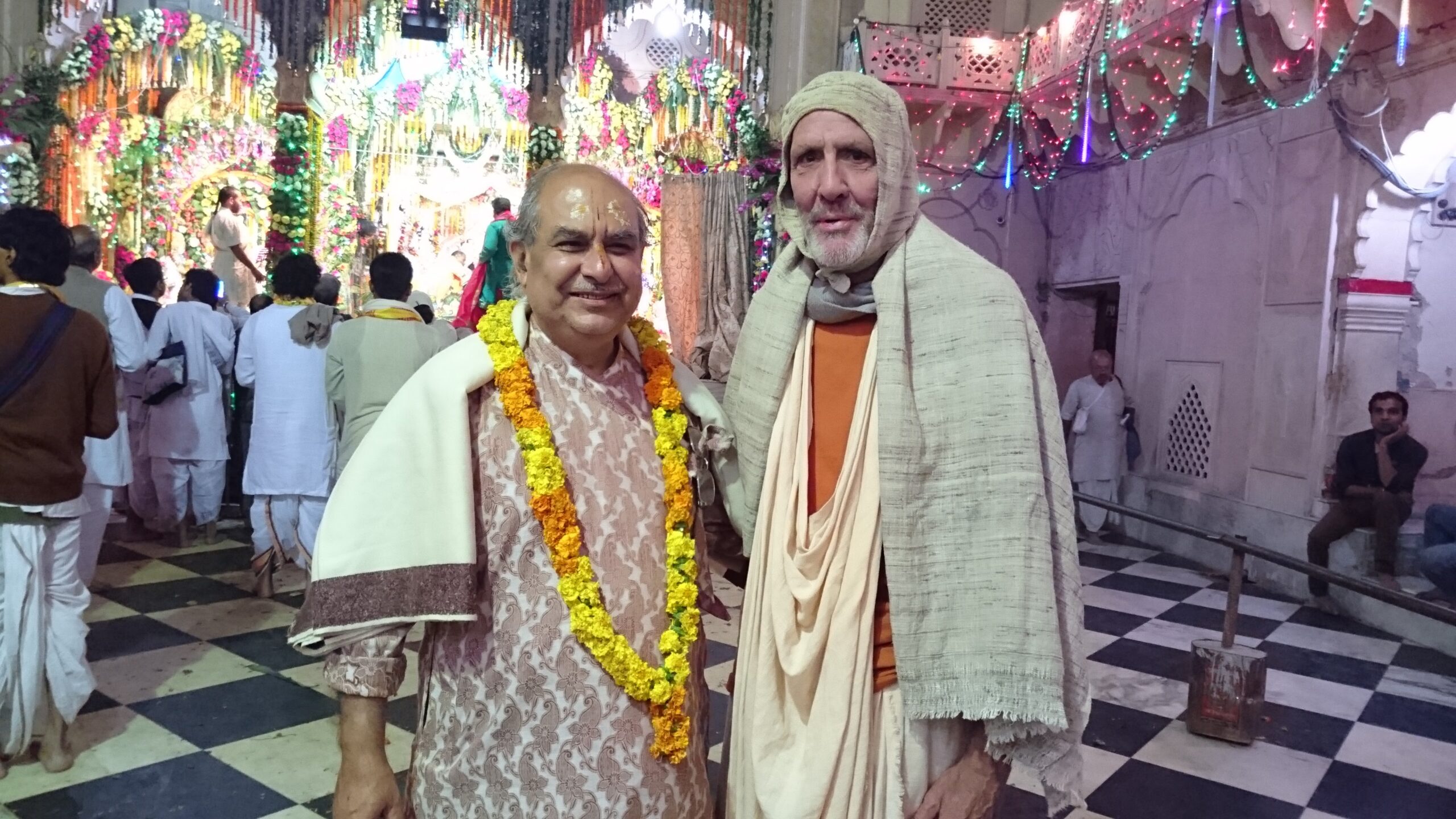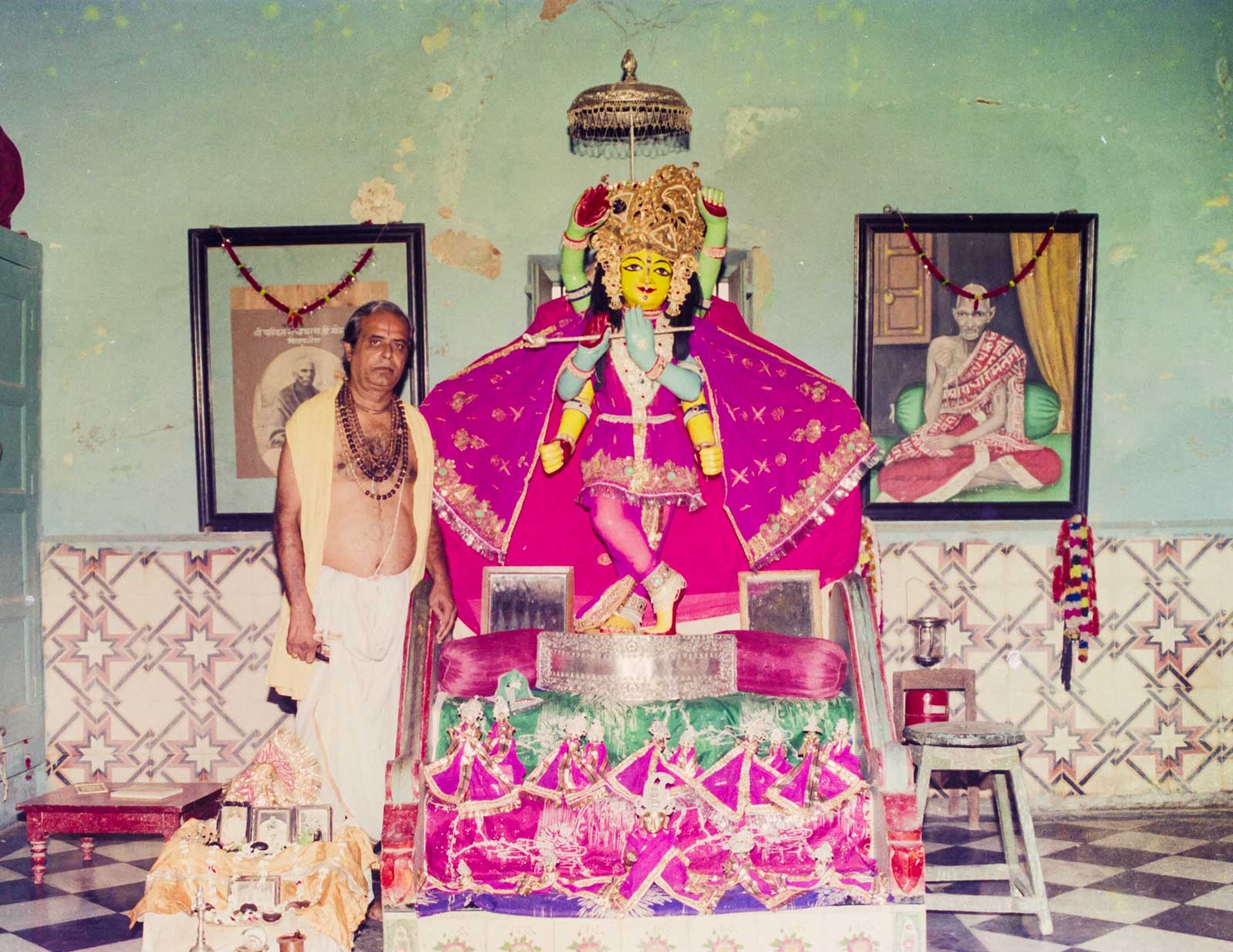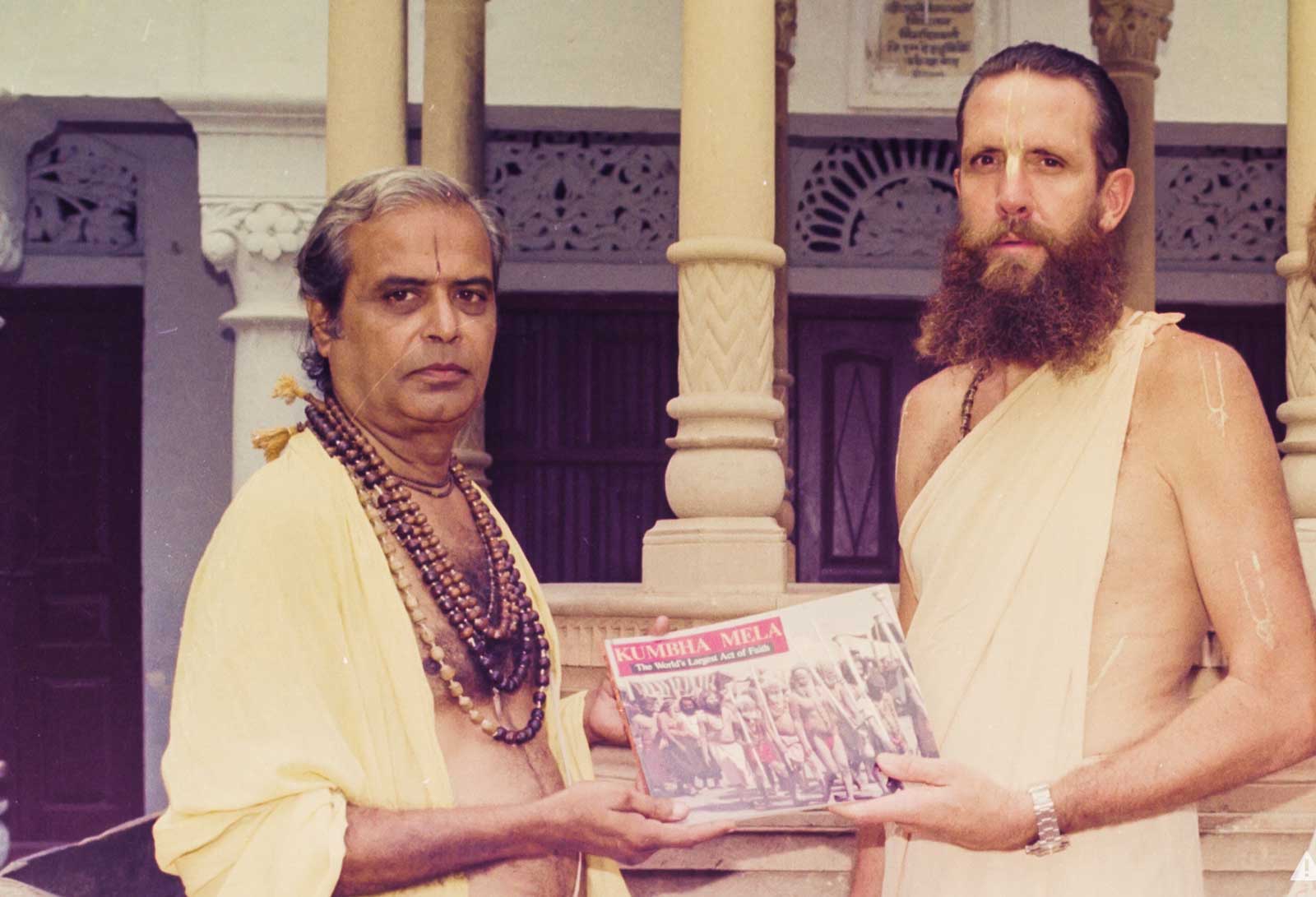Overview
Continuing with our series, ‘Pilgrimage with Swami Narasiṅgha’, this week we go to the famous Rādhā-Ramaṇa Temple in Śrī Vṛndāvana-dhāma where Mahārāja explains the origins of the Deity of Rādhā-Ramaṇa and some history of the temple. This article is adapted from a talk given in Vṛndāvana in 1996 and from two essays written by Mahārāja in 1994.
While He was touring South India, Śrī Caitanya Mahāprabhu arrived in Śrī Raṅgam at the beginning of Cāturmāsya (the four months of the rainy season). There, he established a friendship with Veṅkata Bhaṭṭa, the head priest of the Raṅganātha temple and Veṅkata Bhaṭṭa asked Him to remain in his house for the duration of Cāturmāsya. While He stayed there He was served by Veṅkata Bhaṭṭa’s son, Gopāla Bhaṭṭa who became very attached to Mahāprabhu and even though he was very young, he made up his mind to accept Him as his only shelter.
When Gopāla was about thirty years old, after his mother and father had passed away, he travelled north and came to Vṛndāvana where he stayed under the shelter of Rūpa Gosvāmī and Sanātana Gosvāmī. While he was in Vṛndāvana, Mahāprabhu appeared in a dream to him and told him to make a pilgrimage to the Gaṇḍakī River in Nepal. Mahāprabhu also told him that he would soon get His darśana.
Gopāla Bhaṭṭa Gosvāmī set out on foot, and after a long journey of six months, he reached the Gaṇḍakī River and took bath there. While he was bathing, he placed his water-pot in the river and when he pulled it out he found that several śālagrāma-śilās had entered the pot. He took them out, placed them back in the water, put his pot in the river again, and saw that the śālagrāma-śilās had re-entered the water-pot. Once again, he removed them, placed them back in the Gaṇḍakī, and again the same thing happened. This time, Gopāla Bhatta saw that twelve śālagrāma-śilās had entered his water-pot. Gopāla Bhaṭta considered this to be the mercy of Lord Caitanya and he decided to bring those twelve śālagrāma-śilās back to Vṛndāvana.
While Gopāla Bhaṭṭa was worshipping his śālagrāmas, he was always thinking of Mahāprabhu’s promise that he would soon get His darśana. One day, a rich merchant came to Vraja and approached Gopāla Bhaṭṭa with dresses and silver and gold ornaments for his śālagrāmas, but because all of Gopāla Bhaṭṭa Gosvāmī’s śālagrāmas were round, the dresses and ornaments were not suitable, so Gopāla Bhaṭṭa requested that the man give them to another temple in Vṛndāvana where there was a Deity form of Kṛṣṇa being worshipped. However, that man refused to take them back and so Gopāla Bhaṭṭa kept them with his śālagrāmas.
(Śrī Gopāla Bhaṭṭa Gosvāmī)
Gopāla Bhaṭṭa Gosvāmī would keep all his śālagrāmas in a straw basket, and at night he would tie the basket in a cloth and hang it from a branch of a tree to keep the śālagrāmas off the ground. On the evening of Narasiṁha Caturdaśī, the appearance day of Lord Narasiṁha, Gopāla Bhaṭṭa was reading the story of Prahlāda-Nṛsiṁha from the Śrīmad Bhāgavatam, and feeling intense emotions, he fell unconscious. In the morning when he woke up, he noticed that there was a large shape under the cloth that covered his śālagrāmas. At first, he thought it was a cobra, so he took a stick and gently poked at it, and when it didn’t move, he removed the cloth. He found that from one of the twelve śālagrāmas, which was a dāmodara-śilā, a beautiful Deity of Kṛṣṇa had manifested.
Gopāla Bhaṭṭa went to Rūpa-Sanātana and the other Vaiṣṇavas and showed them the Deity and they all said categorically that the Deity had appeared in order to fulfil Mahāprabhu’s promise to Gopāla Bhaṭṭa Gosvāmī. This Deity of Kṛṣṇa, who is only about twelve inches high, was named Rādhā-Ramaṇa which means ‘the lover of Rādhā.’
(Śrī Śrī Rādhā-Ramaṇa)
The Rādhā-Ramaṇa gosvāmīs are probably the strongest gosvāmī community in Vraja with something like forty-four branches. I remember many years ago, I went with a friend to see Viśvambhara Gosvāmī at Rādhā-Ramaṇa Temple. He was from one of the main families that serve Rādhā-Ramaṇa and he was the father of my old friend, Padmanābha Gosvāmī. Viśvambhara Gosvāmī was also a good friend and supporter of Śrīla Prabhupāda. While we were talking with Viśvambhara Gosvāmī, he happened to mention how the original dāmodara-śālagrāma could still be seen on the back of Rādhā-Ramaṇa. Then the devotee with me asked, “Oh really? Could you show that to us sometime?” Viśvambhara Gosvāmī became very serious, looked him in the eyes and said, “On festivals we sometimes show everyone by using a mirror – you can come and see then. But we cannot disturb Him whenever we like, just to satisfy our curiosity!” I understood immediately what he was saying – why was this devotee demanding to see the śālagrama on Rādhā-Ramaṇa’s back? Because he wanted to be certain that the story of His origin was true. He lacked faith, and in order to have faith, he needed empirical evidence – he wanted what Śrīla Śrīdhara Mahārāja called, ‘an eye experience.’
(Viśvambhara Goswami with Śrīla Prabhupāda)
Many devotees ask why there is no Deity of Rādhārāṇī next to Rādhā-Ramaṇa. Padmanābha Gosvāmī told me that after the time of Gopāla Bhaṭṭa, the gosvāmīs of the temple decided to install a Deity of Rādhārāṇī next to Rādhā-Ramaṇa. The night after She was installed, they locked the doors of the altar and the temple, and the next morning when they opened them, She had vanished! It was impossible that She had been stolen, so the gosvāmīs thought that perhaps Rādhārāṇī had quarrelled with Kṛṣṇa and becoming angry, She had gone away. After some time, news came to them that a deity of a goddess had been discovered inside a well in a town called Gurugram on the way to Delhi. The gosvāmīs went there and sure enough, it was the same deity that they had installed. The townspeople had built a temple to her and were calling her Śītalā Devī, the goddess who wards off disease. She is still in that temple to this day. The gosvāmīs understood that this deity was not in fact Rādhārāṇī, but Yogamāyā Devī. All the gosvāmī families of Rādha-Ramaṇa Temple take their children to that temple when they come of age for their mundana-saṁskāra (hair cutting ceremony).
(Śītalā Devī)
Since the Deity was originally called Rādhā-Ramaṇa, it presupposes that the presence of Śrīmatī Rādhārāṇī is also included there. Rādhā and Kṛṣṇa are always together – They can never be separated. In that sense, one could say that Rādhā-Ramaṇa is also non-different from Lord Caitanya since He is Rādhā-Kṛṣṇa combined. Mahāprabhu told Gopāla Bhaṭṭa Gosvāmī in his dream that He would have darśana of Him soon – so He manifested Himself as Rādhā-Ramaṇa. However, to represent Rādhārāṇī, the gosvāmīs of the temple have placed a small golden brick next to Rādhā-Ramaṇa with the Name of Rādhā inscribed on it which they decorate with a crown and a dress.
For a few hundred years, before the present temple was built, Rādhā-Ramaṇa was kept in a small shrine, When Aurangzeb’s army came to Vṛndāvana, Rādhā-Ramaṇa was safe, firstly, because being so small, He was very easy to hide. Secondly, the temple that He was in was not very big at that time.
Where the present temple is now, there was a large lake which was connected to the Yamunā, and the gosvāmīs of Rādhā-Ramaṇa temple bought that land so that they could use the lake for the Deity. To protect the Deity from dacoits, at night they would put the Deity on a boat, sail out into the middle of the lake and anchor it. They would stand watch with spears, bows and arrows – and the arrows were dipped in poison. The arrows didn’t even have to completely pierce, if they just nicked you, you were dead. They still have those old arrows at the temple, I’ve seen them. Originally, there were some squatters from Rajasthan on the shore of that lake and they refused to leave. Eventually, one local king came and threatened them, so the squatters sent word to another king in Rajasthan who sent troops to Vṛndāvana and there was a violent clash. Finally, the squatters were removed and the lake was used for the Deity for many years.
Then at the beginning of the 19th Century, a wealthy merchant named Shah Kundan Lal and his brother came and built the famous Shahji temple in Vṛndāvana. Their initiated names were Lalita Madhurī and Lalita Kiśorī. I heard that their plan was to make an opulent palace for Rādhā-Ramaṇa to live in. You couldn’t build a palace like that today for half a million dollars – most of the palace is made of marble. It has big pillars which are twisted like grape vines, there are huge, beautiful chandeliers, and every room has a dais for the Deity – the whole palace was made in order that Rādhā-Ramaṇa could be moved from room to room for different sevās. When the palace was completed, they invited Rādhā-Ramaṇa to come, but for some reason it didn’t happen. I heard from Viśvambhara Gosvāmī that at that time, the gosvāmīs told them, “Wherever Thākurajī is living, we always live with Him, so where will His servants live?” The palace was not made for humans to live in – it was only arranged for the Deity. The gosvāmīs suggested that Lalita Madhurī and Lalita Kiśorī should install small Deities there, and so they installed the Deities of Choṭe Rādhā-Ramaṇa that are there today. Then their grandfather, Shahji Bihari Lal, came and drained the lake in order to build the present Rādhā-Ramaṇa temple with accommodation for all the sevaites.
At the Rādhā-Ramaṇa Temple. they have a fire in the temple kitchen that they say was first lit by Gopāla Bhaṭṭa Gosvāmī and it has been constantly burning for over four hundred and fifty years. Every morning they stoke the coals and start another fire. They cook a special offering called kuliyā which is made from whole milk and raw sugar. It is placed in a large pot, and the milk and sugar are cooked together until they reach a consistency almost like peanut butter. Then the kuliyā is placed into thousands of small clay cups, offered to the Deity, and distributed to the public.
(Kuliyā Prasāda)
I would have to say that Rādhā-Ramaṇa Temple is probably the most traditional and most orthodox temple in Vraja. But at the same time, they are also very innovative and broad-minded. When steam-engines became a thing in India, they immediately made a small, solid silver locomotive for Rādhā-Ramaṇa to play with! Also, when Śrīla Bhaktisiddhānta Sarasvatī Ṭhākura first came to Vṛndāvana to perform Vraja-maṇḍala Parikramā, all the major temples of Vṛndāvana refused entry to the Gauḍīya Maṭha devotees because Sarasvatī Ṭhākura was not a brāhmaṇa and was giving gāyatrī initiation to his disciples. “Why is he taking hari-nāma in the street? This is not right. Look! He has non-brāhmaṇas wearing threads! He is allowing them to touch śālagrāma!” They had a list of complaints against Sarasvatī Ṭhākura as long as your arm. The only temple that opened its doors to Sarasvatī Ṭhākura was the Rādhā-Ramaṇa Temple. Madhusūdana Gosvāmī, the grandfather of Viśvambhara Gosvāmī, was a friend of Bhaktivinoda Ṭhākura and had previously spoken in support of Sarasvatī Ṭhākura at the famous brāhmaṇa-Vaiṣṇava debate in Bengal. He came and welcomed Sarasvatī Ṭhākura with a big garland and the saṅkīrtana party entered the temple and they were dancing in the courtyard. Then some talks were given and Sarasvatī Ṭhākura said, “It is very wonderful that today, I had darśana of all the Ṭhākurajīs of Vraja in one! I had darśana of Govindajī, Gopīnātha, Madana-mohana, Śyāmasundara, Gokulānanda and Dāmodara in Rādhā-ramaṇa.”
(Madhusūdana Goswami)
Besides Viśvambhara Goswami and Padmanābha Goswami, I also knew Śrī Caitanya Goswami who was in charge of the Ṣad-bhuja Mahāprabhu Temple near to Rādhā-Ramaṇa. When I first came to live in Vṛndāvana, he took care of me and through Padmanābha Goswami, he arranged a room for me at the Āmiya Nimāi Temple (which is also run by the Rādhā-Ramaṇa Temple) in Gopīnātha Bazaar. So we can see that the Rādhā-Ramaṇa Temple has always been favourable to the devotees of our sārasvata–paramparā.
Related Articles and Books
- 📚Pilgrimage With Swami Narasiṅgha Series Index
- 📖 In Search of the Ultimate Goal of Life by Śrīla A.C. Bhaktivedānta Swami Prabhupāda
- 📖 Śrī Dāmodara Kathā by Śrīla Bhakti Gaurava Narasiṅgha Mahārāja
- 📖 Prabhupāda Vijaya by Śrīla Bhakti Gaurava Narasiṅgha Mahārāja
- The Ontological Position of Śrī Śrī Rādhā-Govinda by Śrīla B.R. Śrīdhara Deva Gosvāmī
- Śrī Govardhana Pūjā by Śrīla Bhakti Rakṣaka Śrīdhara Deva Gosvāmī
- The Vṛndāvana Express and the Navadvīpa Special by Śrīla Bhakti Rakṣaka Śrīdhara Deva Gosvāmī
- Vraja Bhāva by Śrīla Bhakti Gaurava Narasiṅgha Mahārāja
- The Worship of Govardhana by Śrīla Bhakti Gaurava Narasiṅgha Mahārāja
- Dāsa Gosvāmī and the Unique Position of Govardhana by Śrīla Bhakti Gaurava Narasiṅgha Mahārāja
- Ācāryas at Śrī Śrī Rādhā-Dāmodara Temple, Vṛndāvana by Śrīla Bhakti Gaurava Narasiṅgha Mahārāja
- Pilgrimage to Vṛndāvana-dhāma by Śrīla Bhakti Gaurava Narasiṅgha Mahārāja
- The Appearance of Rādhā-kuṇḍa by Śrīla Bhakti Gaurava Narasiṅgha Mahārāja
- Prema Dhāma Deva Stotram with the Narasiṅgha Sevaka Commentary – Verses 41-45 (regarding Imlitalā) by Swami B.V. Giri
Further Reading
Pilgrimage with Swami Narasiṅgha – Part 7: Keśī Ghāṭa
Continuing with our pilgrimage series, this week Śrīla Narasiṅgha Mahārāja takes us to Keśī Ghāṭā where he tells us about Madhumaṅgala’s meeting with the Keśī demon, what Keśī represents, and how Śrīla Prabhupāda almost acquired Keśī Ghāṭa. Mahārāja also narrates his own experience. This article has been adapted from a number of talks and articles by Narasiṅgha Mahārāja.
Prema Dhāma Deva Stotram with the Narasiṅgha Sevaka Commentary – Verses 61-65
In verses 61 to 65 of 'Prema Dhāma Deva Stotram', Śrīla Śrīdhara Mahārāja narrates the pastime of Śrī Caitanya at Caṭaka Parvata In Purī and explains how the scriptures produced by Brahmā and Śiva are ultimately searching for the personality of Mahāprabhu who is merciful too all jīvas, no matter what their social position.
Prabhupāda Śrīla Sarasvatī Ṭhākura’s Visit to Ayodhyā
With the forthcoming observance of Śrī Rāma Navamī, we present 'Prabhupāda Śrīla Sarasvatī Ṭhākura’s Visit to Ayodhyā' written by Śrīla Bhaktisiddhānta Sarasvatī Ṭhākura Prabhupāda from The Gaudīyā magazine, Vol 3. Issue 21/ In December 1924, after visiting Benares and Prāyāga, Sarasvatī Ṭhākura visited the birth-site of Śrī Rāmācandra in Ayodhyā.
Śaraṇāgati – The Only Path to Auspiciousness
In this article, 'Śaraṇāgati - The Only Path to Auspiciousness', Dhīra Lalitā Dāsī analyses the process of śaraṇāgati (surrender) beginning with śraddhā (faith). She also discusses the role of śāstra and the Vaiṣṇava in connection with surrender.
Pilgrimage with Swami Narasiṅgha – Part 7: Keśī Ghāṭa
Continuing with our pilgrimage series, this week Śrīla Narasiṅgha Mahārāja takes us to Keśī Ghāṭā where he tells us about Madhumaṅgala’s meeting with the Keśī demon, what Keśī represents, and how Śrīla Prabhupāda almost acquired Keśī Ghāṭa. Mahārāja also narrates his own experience. This article has been adapted from a number of talks and articles by Narasiṅgha Mahārāja.
Prema Dhāma Deva Stotram with the Narasiṅgha Sevaka Commentary – Verses 61-65
In verses 61 to 65 of 'Prema Dhāma Deva Stotram', Śrīla Śrīdhara Mahārāja narrates the pastime of Śrī Caitanya at Caṭaka Parvata In Purī and explains how the scriptures produced by Brahmā and Śiva are ultimately searching for the personality of Mahāprabhu who is merciful too all jīvas, no matter what their social position.
Prabhupāda Śrīla Sarasvatī Ṭhākura’s Visit to Ayodhyā
With the forthcoming observance of Śrī Rāma Navamī, we present 'Prabhupāda Śrīla Sarasvatī Ṭhākura’s Visit to Ayodhyā' written by Śrīla Bhaktisiddhānta Sarasvatī Ṭhākura Prabhupāda from The Gaudīyā magazine, Vol 3. Issue 21/ In December 1924, after visiting Benares and Prāyāga, Sarasvatī Ṭhākura visited the birth-site of Śrī Rāmācandra in Ayodhyā.
Śaraṇāgati – The Only Path to Auspiciousness
In this article, 'Śaraṇāgati - The Only Path to Auspiciousness', Dhīra Lalitā Dāsī analyses the process of śaraṇāgati (surrender) beginning with śraddhā (faith). She also discusses the role of śāstra and the Vaiṣṇava in connection with surrender.


